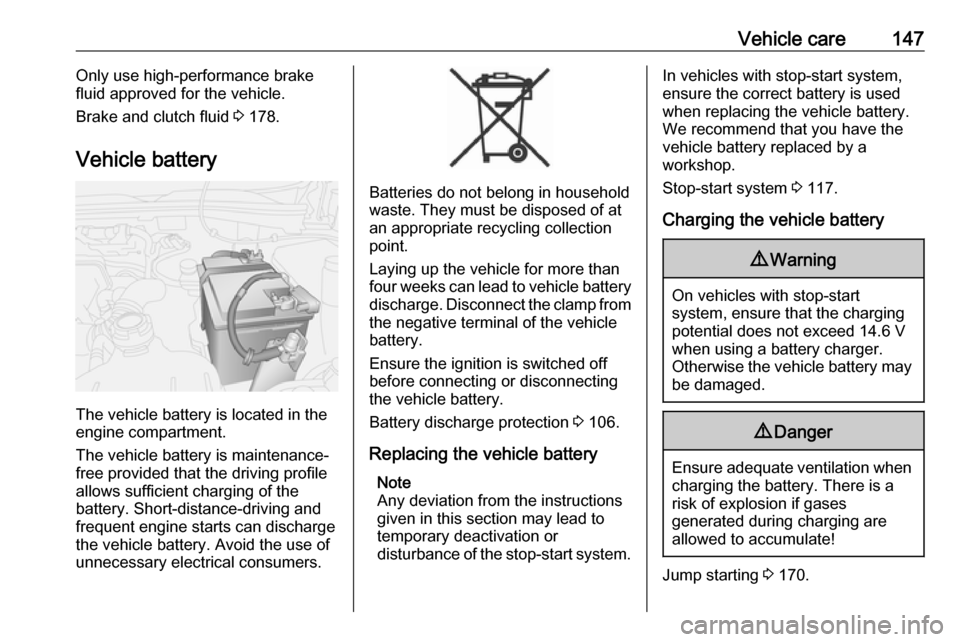jump start OPEL COMBO D 2018 Manual user
[x] Cancel search | Manufacturer: OPEL, Model Year: 2018, Model line: COMBO D, Model: OPEL COMBO D 2018Pages: 203, PDF Size: 4.97 MB
Page 143 of 203

Vehicle care141Vehicle careGeneral Information...................141
Accessories and vehicle modifications .......................... 141
Vehicle storage ........................142
End-of-life vehicle recovery .....142
Vehicle checks ........................... 143
Performing work ......................143
Bonnet ..................................... 143
Engine oil ................................. 144
Engine coolant ......................... 145
Power steering fluid .................145
Washer fluid ............................ 146
Brakes ..................................... 146
Brake fluid ............................... 146
Vehicle battery ......................... 147
Wiper blade replacement ........148
Bulb replacement .......................149
Halogen headlights ..................149
Fog lights ................................. 151
Tail lights ................................. 151
Side turn signal lights ..............152
Centre high-mounted brake light ......................................... 152
Number plate light ...................153Interior lights ............................ 154
Instrument panel illumination ...155
Electrical system ........................155
Fuses ....................................... 155
Engine compartment fuse box . 156
Instrument panel fuse box .......157
Vehicle tools .............................. 159
Tools ........................................ 159
Wheels and tyres .......................160
Winter tyres ............................. 160
Tyre designations ....................160
Tyre pressure .......................... 160
Tyre pressure monitoring
system .................................... 161
Tread depth ............................. 163
Changing tyre and wheel size . 163 Wheel covers ........................... 163
Tyre chains .............................. 164
Tyre repair kit .......................... 164
Wheel changing .......................166
Spare wheel ............................ 168
Jump starting ............................. 170
Towing ....................................... 172
Towing the vehicle ...................172
Towing another vehicle ...........173
Appearance care .......................173
Exterior care ............................ 173
Interior care ............................. 176General Information
Accessories and vehiclemodifications
We recommend the use of genuine
parts and accessories and factory
approved parts specific for your
vehicle type. We cannot assess or guarantee reliability of other products
- even if they have a regulatory or
otherwise granted approval.
Any modification, conversion or other
changes made to standard vehicle
specifications (including, without
limitation, software modifications,
modifications of the electronic control units) may invalidate the warrantyoffered by Opel. Furthermore, such
changes may affect driver assistance
systems, may impact fuel
consumption, CO 2 emissions and
other emissions of the vehicle and
cause the vehicle to no longer
conform to the operating permit,
impacting the validity of your vehicle
registration.
Page 149 of 203

Vehicle care147Only use high-performance brake
fluid approved for the vehicle.
Brake and clutch fluid 3 178.
Vehicle battery
The vehicle battery is located in the
engine compartment.
The vehicle battery is maintenance-
free provided that the driving profile
allows sufficient charging of the
battery. Short-distance-driving and
frequent engine starts can discharge
the vehicle battery. Avoid the use of
unnecessary electrical consumers.
Batteries do not belong in household
waste. They must be disposed of at
an appropriate recycling collection
point.
Laying up the vehicle for more than
four weeks can lead to vehicle battery
discharge. Disconnect the clamp from
the negative terminal of the vehicle
battery.
Ensure the ignition is switched off
before connecting or disconnecting
the vehicle battery.
Battery discharge protection 3 106.
Replacing the vehicle battery Note
Any deviation from the instructions
given in this section may lead to temporary deactivation or
disturbance of the stop-start system.
In vehicles with stop-start system,
ensure the correct battery is used
when replacing the vehicle battery.
We recommend that you have the
vehicle battery replaced by a
workshop.
Stop-start system 3 117.
Charging the vehicle battery9 Warning
On vehicles with stop-start
system, ensure that the charging potential does not exceed 14.6 V
when using a battery charger.
Otherwise the vehicle battery may be damaged.
9 Danger
Ensure adequate ventilation when
charging the battery. There is a
risk of explosion if gases
generated during charging are
allowed to accumulate!
Jump starting 3 170.
Page 172 of 203

170Vehicle care
1. Unscrew two bolts using thewheel wrench and remove spare
wheel from bracket.
Vehicle tools 3 159.
2. Change the wheel.
3. Position the replaced spare wheel
onto the bracket ensuring correct
alignment of the locating pin.
4. Secure spare wheel by tightening two bolts using the wheel wrench.
Have the defective tyre renewed or
repaired as soon as possible.
Directional tyres If possible, fit directional tyres such
that they roll in the direction of travel.
The rolling direction is indicated by a
symbol (e.g. an arrow) on the
sidewall.
The following applies to tyres fitted
opposing the rolling direction:
● Driveability may be affected. Have the defective tyre renewed
or repaired as soon as possible
and fit it instead of the spare
wheel.
● Drive particularly carefully on wet
and snow-covered road
surfaces.Jump starting
Do not start with quick charger.
A vehicle with a discharged battery can be started using jump leads and
the battery of another vehicle.9 Warning
Be extremely careful when starting
with jump leads. Any deviation
from the following instructions can
lead to injuries or damage caused
by battery explosion or damage to the electrical systems of both
vehicles.
9 Warning
Avoid contact of the vehicle
battery with eyes, skin, fabrics and painted surfaces. The fluid
contains sulphuric acid which can
cause injuries and damage in the
event of direct contact.
● Never expose the vehicle battery
to naked flames or sparks.
Page 173 of 203

Vehicle care171● A discharged vehicle battery canalready freeze at a temperature
of 0 °C. Defrost the frozen battery before connecting jump leads.
● Wear eye protection and protective clothing when
handling a vehicle battery.
● Use a booster battery with the same voltage (12 V). Its capacity
(Ah) must not be much less than
that of the discharged vehicle
battery.
● Use jump leads with insulated terminals and a cross section of
at least 16 mm 2
(25 mm 2
for
diesel engines).
● Do not disconnect the discharged
battery from the vehicle.
● Switch off all unnecessary electrical consumers.
● Do not lean over the vehicle battery during jump starting.
● Do not allow the terminals of one
lead to touch those of the otherlead.● The vehicles must not come into contact with each other during
the jump starting process.
● Apply the parking brake, transmission in neutral.
Lead connection order:
1. Connect the red lead to the positive terminal of the booster
battery.
2. Connect the other end of the red lead to the positive terminal of the
discharged vehicle battery.
3. Connect the black lead to the negative terminal of the booster
battery.
4. Connect the other end of the black
lead to a vehicle grounding point,
such as the engine block or an
engine mounting bolt. Connect as far away from the discharged
vehicle battery as possible,
however at least 60 cm.
Route the leads so that they cannot
catch on rotating parts in the engine
compartment.
To start the engine: 1. Start the engine of the vehicle providing the jump.
2. After five minutes, start the other engine. Start attempts should be
made for no longer than
15 seconds at an interval of
one minute.
3. Allow both engines to idle for approx. three minutes with the
leads connected.
Page 174 of 203

172Vehicle care4. Switch on electrical consumers(e.g. headlights, heated rear
window) of the vehicle receiving
the jump start.
5. Reverse above sequence exactly when removing leads.Towing
Towing the vehicle
Release the cap by carefully lifting
with a screwdriver. To prevent
damage, it is recommended to place
a cloth between the screwdriver and
the frame.
The towing eye is stowed with the vehicle tools 3 159.
Screw in the towing eye as far as it will
go until it stops in a horizontal
position.
Attach a tow rope – or better still a tow
rod – to the towing eye.
Caution
The towing eye must only be used for towing and not for recovering
the vehicle.
Switch on ignition to release steering
wheel lock and to permit operation of
brake lights, horn and windscreen
wiper.
Switch the selector lever to neutral.
Release the parking brake.
Note
If neutral cannot be selected on
vehicles with manual transmission
automated (MTA), the vehicle must
only be towed with the drive wheels
raised off the ground.
Caution
Drive slowly. Do not drive jerkily.
Excessive tractive force can
damage the vehicle.
When the engine is not running,
considerably more force is needed to
brake and steer.
Page 200 of 203

198GGauges ......................................... 77
Gear shifting ................................. 86
General information ...................139
Generic warning .............82, 97, 116
Glovebox ..................................... 62
Gross Vehicle Weight ...................68
H
Halogen headlights ....................149
Hand brake ................................. 128
Hazard warning flashers ............101
Headlamp washer......................... 73
Headlight flash ........................... 100
Headlight range adjustment ......101
Headlights................................... 100
Headlights when driving abroad 101
Head restraint adjustment .............8
Head restraints ............................ 35
Heated mirrors ............................. 31
Heated rear window ..................... 34
Heating ........................................ 40
Heating and ventilation system . 107
High beam ........................... 90, 100
Hill start assist ...................... 86, 128
Horn ....................................... 14, 71
I
Identification plate .....................181
Ignition switch positions .............115
Immobiliser ............................ 29, 90Indicators...................................... 77
Information displays...................... 91
Initial drive information.................... 6
Installing seats .............................. 42
Instrument cluster ........................77
Instrument panel fuse box .........157
Instrument panel illumination .....155
Instrument panel illumination control .................................... 103
Instrument panel overview ........... 10
Instrument panel storage ..............61
Interior care ............................... 176
Interior lighting ......................91, 103
Interior lights ...................... 104, 154
Interior mirrors .............................. 31
Introduction .................................... 3
ISOFIX .......................................... 55
J
Jump starting ............................. 170
K Kerb weight................................... 68Key number .................................. 20
Keys ............................................. 20
Keys, locks ................................... 20
L
Language ..................................... 91
Lashing eyes ......................... 66, 68
Laying up the vehicle ..................147Light switch ................................ 100
Load compartment ................28, 63
Load compartment cover .............64
Load compartment grille ...............67
Load compartment lighting .........105
Loading ............................. 38, 41, 42
Loading information .............68, 188
Loadspace dimensions ...............188
Lock cylinders ............................... 20
Low engine oil level .....................89
Low fuel ....................................... 89
Luggage floor net .........................66
Lumbar support ............................ 37
M
Malfunction indicator light ............84
Manual adjustment ......................30
Manual anti-dazzle ......................31
Manual door locks ........................22
Manual mode ............................. 125
Manual transmission .................. 122
Manual transmission automated 123
Manual windows ..........................32
Mirror adjustment ........................... 8
Misted light covers .....................103
Multifunction display .....................91
N Natural gas ................................. 190
New vehicle running-in ..............115
Number plate light .....................153